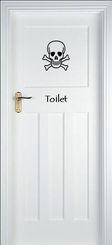Toxic chemicals can turn up in unexpected places and it wasn’t until using a hotel bathroom a few weeks ago that I was reminded of these hidden dangers. The odour from the cleaning product that had been used in the toilet made me gasp. Here is a situation where people with allergies and respiratory problems could find themselves exposed to certain chemicals that could trigger an unsuspected reaction.
|
Investigating what ingredients are commonly used in toilet cleaners, I looked for an example at the label of a well known brand. This revealed firstly, the use of a mixture of methylchloroiothazolinone and methylisothazolinone (M1). It is known that both of these can provoke an allergic reaction, in fact, dermatologists have stated that MI is the most common cause of contact dermatitis in the European patient population. See article on allergies.
FACE PROTECTION ADVISED One of the other ingredients warned that it could cause serious damage to the eyes which was no doubt why the label on the container advises wearing protection for the hands and eyes before use. I wonder how many people take this into account before using toilet cleaners? It would be all too easy to inadvertently splash tiny droplets onto the skin, or worse, into the eyes. 
Most labels attract the customer with images on the container of snow capped mountains or woodland scenes suggesting how environmentally friendly and safe they are, and some say they contain essential oils to disguise the fact that the cleaner is actually toxic. Don’t be taken in by products labelled ‘pine fresh ’or ‘lemon perfumed’ for these artificial fragrances can contain hundreds, if not thousands, of chemicals. Fragrances are a major cause of allergic reactions. Toluene, a chemical made from petroleum or coal tar is found in most synthetic fragrances; it is harmful if inhaled or absorbed through the skin.
|

HAZARDOUS POLLUTANTS
Professor Anne Steinemann is internationally recognised for her research on indoor air quality, consumer product emissions, and exposure assessment. She serves as adviser to governments and industries around the world. In a lecture given in Melbourne in March 2017, she stated ‘contrary to popular belief, most of our exposure to hazardous pollutants occurs in places we consider safe—indoor environments, such as homes, schools, and workplaces. Primary sources of these pollutants are also considered safe—everyday consumer products, such as cleaning supplies, air fresheners, and personal care products. However, indoor air environments are generally unregulated, and consumer products are not required to disclose all ingredients. Even so-called ‘green’ products can emit hazardous pollutants.’ Clearly, chemical cleaning products, especially toilet cleaners have no place in areas continually used by children and young people who are often more sensitive to toxic materials than adults. SIMPLE SOLUTION Fortunately, help is at hand. There are other simple, inexpensive solutions for cleaning in the bathroom and about the house and one such is ordinary white vinegar, found in the cupboard of most kitchens. Not only does white vinegar kill bacteria, germs, and mould quite readily, but as it is acidic it acts as a natural lime remover which makes it ideal for use in hard water areas and a non toxic but effective toilet cleaner. Studies have shown that an average bottle of white vinegar (usually a solution of between 5% -10%) will kill just as many germs as any antibacterial concoction that you will find on the supermarket shelf. |
The time has come to rid the family home of toxic cleaning materials that lurk in both the bathroom and the kitchen and return to time tested, basic products that are safe, available at a fraction of the cost and yet are just as effective.
